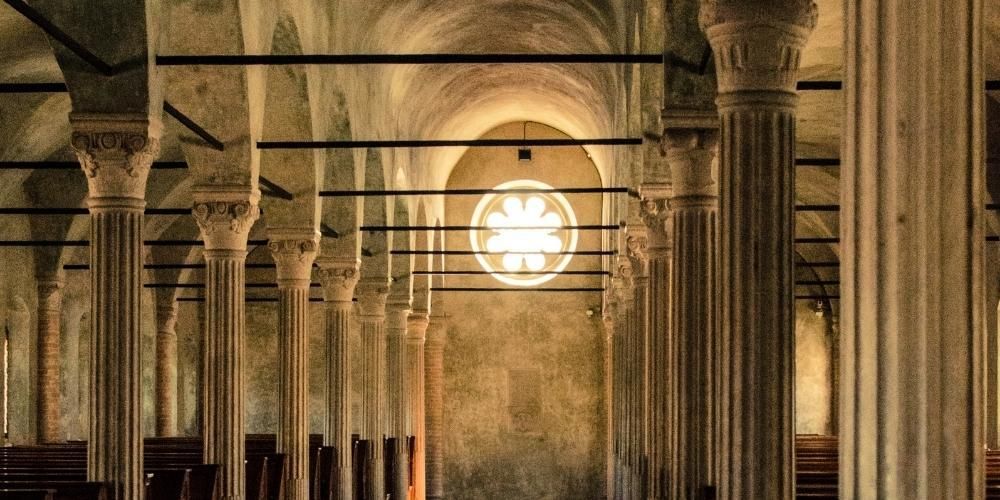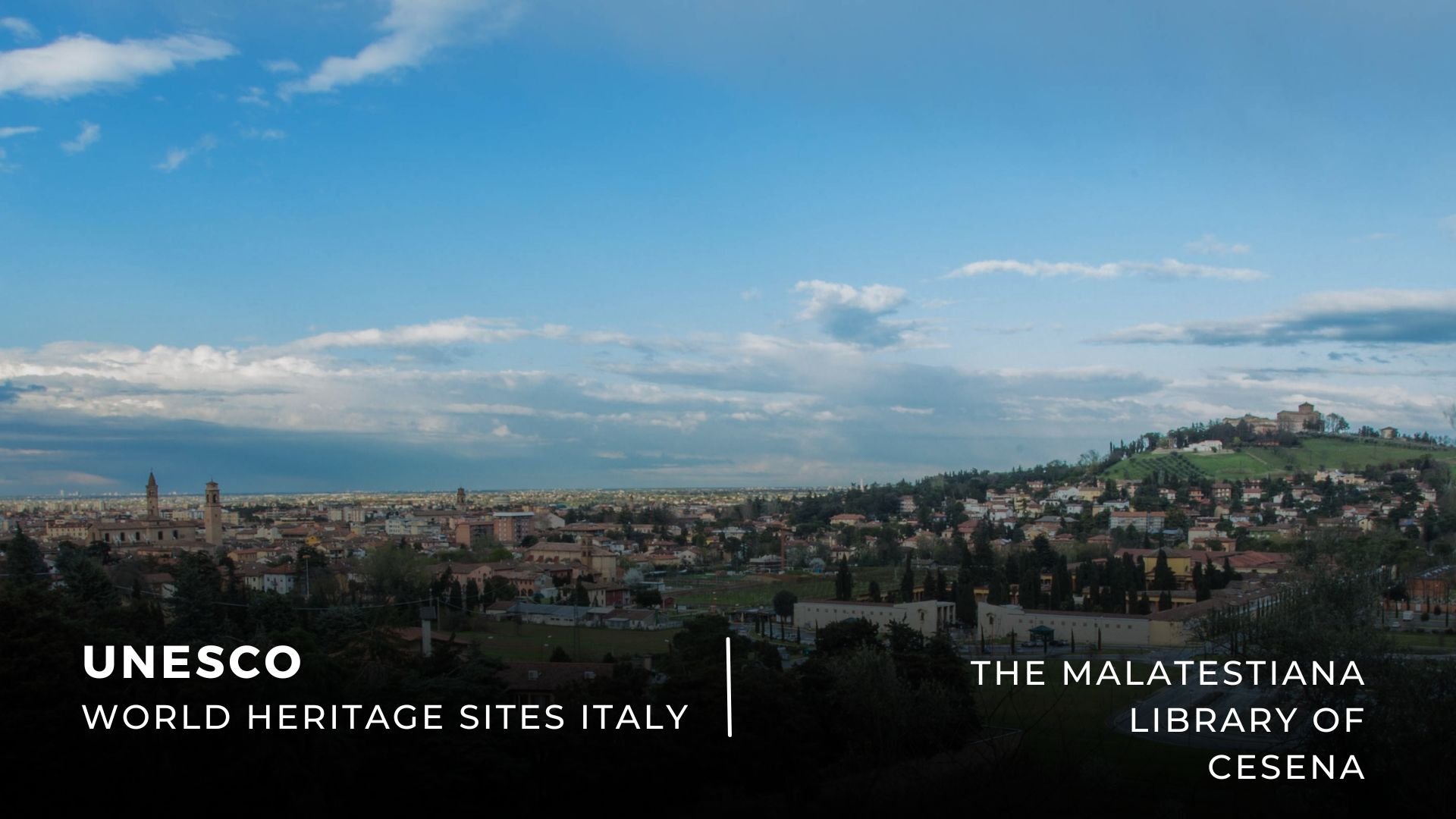In Cesena, there is a place suspended in time where everything seems crystallised since the 15th century. With its 350,000 volumes, the Malatestiana Library represents a monumental and bibliographical complex of inestimable value.
UNESCO recognised its importance by selecting the library as the first ever Italian site to include in the Memory of the World Register.
If you are wondering what makes this place so unique, note that la Malatestiana is the only 15th-century monastic library of humanist heritage in perfect condition.
The almost reverential mystical air makes the atmosphere extraordinary. It's very likely that once you cross its threshold, you'll feel a little in awe. Undoubtedly, the Malatesta Novello Library, which even ended on a postage stamp in 2008, exerts an exceptional appeal.
The institution was a groundbreaking novelty since from the start. Domenico Malatesta (also known as Malatesta Novello) commissioned the building, which features several symbols and engravings linked to Cesena's noble lords. According to the express will of its creator, the municipality was entrusted to the management, so it became the first civic library in Italy.
The fame of the new libreria and its precious collection grew year after year. Such was the prestige that even obtaining a volume loan was not taken for granted.
For a long time, the access keys to the reading room were kept separately for security reasons. The charge was shared between the friars of the Franciscan convent and the municipal institutions.
What remains today is a concentration of history and beauty that anyone should see.
Here are the essentials to know before visiting the Malatestiana Library in Cesena.

The Malatestiana Library of Cesena

The Malatestiana Library of Cesena is the first Italian cultural institution in the UNESCO Memory of the World Register. This recognition arrived in 2005 and attested to its great historical value.
It's the only perfectly intact example of a humanistic Renaissance library. The optimal preservation state affects the structure, furnishings, and the book heritage it houses.
Its history, peppered with intrigues, thefts, spitefulness and a few high-sounding names, seems to have leapt straight out of a 19th-century historical novel.
It all begins at the height of Renaissance fervour. In the mid-15th century, Domenico Malatesta was an enlightened ruler with a marked propensity for art and culture who expressed the desire to build a public library in his city.
Nevertheless, since the lord of Cesena couldn't count on the support of political institutions, he financed the work himself. The new building rose in the Franciscan convent between Piazza Bufalini and Via Montalti. The friars were already accustomed to producing theological, juridical, philosophical and medical codices and volumes and happily accommodated a reading room.
Work began in 1447 under the direction of Matteo Nuti, a pupil of Leon Battista Alberti. The Library of San Marco in Florence inspired the project.
Finally, the so-called Aula Nuti, named after its architect, came to light in 1452. It features a basilica floor plan with three naves surmounted by barrel vaults (centrally) and cross vaults (on the sides). The aisles are divided into rows of columns, each decorated with capitals with unique motifs.
At first glance, the impression you get when entering is that of a church, but a closer look soon reveals the environment's extraordinary uniqueness.
To set foot in Malatestiana Library of Cesena is to turn the hands of time back to 600 years ago.
The library still presents itself as it must have appeared in the 15th century, with wooden desks, manuscripts secured to the lecterns by chains, plastered walls and soft light leaking in through the side windows, the only lighting in the room. The Aula was conceived with such exposure to minimise the need for candles, a fire hazard.
Just opposite the Nuti Hall is La Piana, the personal library of Pope Pius VII, Barnaba Chiaramonti, a native of Cesena. More than 5,000 volumes are preserved here, amid prints and manuscripts including the smallest book in the world readable with the naked eye: it measures 15x9mm, dates back to 1897 and is a reproduction of Galileo Galilei's Letter to Maria Christina of Lorraine.
Guided tours to the Malatesta Library lasts about forty minutes.
What is the UNESCO Memory of the World Programme
The Malatestiana Library of Cesena is a member of UNESCO's Memory of the World. The program was established in 1992 as a tool for awareness, conservation and defence of the world's documentary heritage.
A threatened, immense treasure, often little known or undervalued, which, in some cases, has lacked proper protection and consideration.
The Memory of the World programme aims to preserve the sites listed in the register recommended by the UNESCO International Advisory Committee. It ensures universal access to documentary heritage, gives it maximum visibility and increases its knowledge worldwide, even through new technologies.
Eight Italian cultural sites are included in the Memory of the World register. Some are partnerships with other countries. Here they are:
2005 - The Malatestiana Library of Cesena;
2005 - The Bibliotheca Corviniana Collection (with Austria, Belgium, France, Germany, Hungary);
2011 - Lucca’s Historical Diocesan Archives;
2013 - Newsreels and photographs of Istituto Nazionale L.U.C.E.;
2015 - Codex Purpureus Rossaniensis;
2015 - Collection of Barbanera Almanacs;
2015 - The work of Fray Bernardino de Sahagún (1499-1590) (with Mexico and Spain);
2017 - Antonio Carlos Gomes (with Brazil).
After the Malatestiana Library, the tour of Cesena continues

The Malatestiana Library is just one of the tourist attractions in Cesena. This vibrant art city, often overshadowed by more famous locations nearby like Rimini, on the list of must-see stops in its region: Emilia Romagna.
Spend here at least one day, and we are sure you'll fall in love with something (monuments, museums, squares, food) or— why not—someone.
Cesena is a city on a human scale, perfect for relaxing walking or cycling tours- Furthermore, for Italian cuisine lovers it's a must-stop—the original piadina romagnola, the iconic regional speciality, was born right here.
The main attractions are all quite near, so Cesena is easily accessible to even the most 'clumsy' tourists.
Start your tour from Piazza del Popolo, a lively and harmonious urban corner embellished by a glorious 16th-century fountain, Fontana Masini. Look around and spot a plaque engraved with some verses from Dante's Inferno dedicated to Cesena. You'll find it affixed along the walls of the Rocchetta di Piazza, a fortification defending the Rocca Malatestiana.
Palazzo Albornoz, a 14th-century building that houses the town hall, is one of the palaces that border the area. Turn your back at it and look up to the left: can you spot some curious, 'suspended' fellows? Well, you've just seen Leonardo Lucchi's creations. The sculptor's atelier is nearby and can be visited free of charge.
A ramp behind the Masini fountain takes you to the Rocca Malatestiana, a (panoramic) part of a vast and majestic defensive system. In its heyday, this massive construction left anyone stunned. Even Leonardo da Vinci was impressed.
Via delle Scalette, an old mule track, leads visitors to the Abbey of Santa Maria del Monte. In addition to one of the most important religious monuments in the region, you'll be welcomed by a view as far as the eye can see. The Abbazia houses a precious collection of ex voto paintings—the largest in Europe, with around 700 pieces.
An architectural jewel of the 19th century rises in Piazza Mario Guidazzi: Teatro Bonci. Much loved by Luciano Pavarotti, this theatre is particularly appreciated for its acoustic and stage size, among the largest in the world. Check out the latest shows for an evening of quality entertainment and grab the chance to admire its interiors.
About the author
Written on 04/01/2023



Lorena Calise
So beautiful and iconic to be pictured on a postage stamp. The Malatestiana Library of Cesena is a concentration of history and charm to (re)discover.